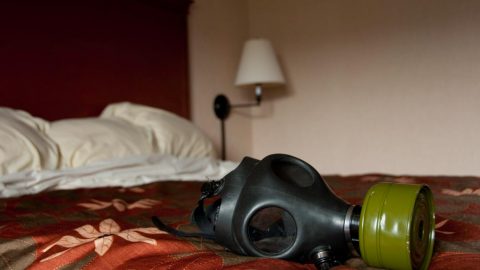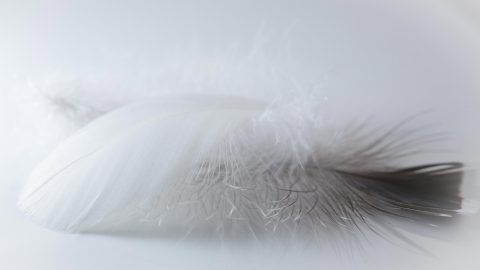
This poor soul just had a dream about a sweaty down pillow that needed to be turned to the cool side.
Trying to sleep on a hot, sweaty pillow sucks. Repeatedly flipping to the cool side in the middle of the night isn’t the way to sleep!
“Cooling pillows” are designed to help regulate your body temperature by absorbing and dissipating heat. Is there such thing as a pillow that stays cool all night long? As it happens, there are several different designs that purport to keep you comfortably cool while you’re sleeping.
How do cooling pillows work?
The most common utilize three primary mechanisms to regulate temperature:
- Breathable pillows enable air to flow freely throughout the pillow’s fill. They prevent warm air from building up.
- Pillows containing water or gels cool your skin with the physics of conduction. You know what cool water feels like — the process of heat transferring from your body to the water or gel quickly makes your skin feel cooler. (note that some orthopedic pillow types are water based pillows. These are not cooling pillows)
- Pillows containing phase-change materials cool with some not-so-simple physics. They’re a bit more difficult to understand than the cooling effect of a bag of water. PCM materials are capable of transferring heat both to and from your body. Heat is absorbed (or released) when the PCMs change from liquid to solid and vice versa. SCIENCE!
I compared four products that represented the different approaches to cooling pillow design:
- a water-based “cooling pillow insert” (a flat water bag that slides inside your existing pillow)
- a memory foam pillow with a cooling gel layer
- another memory foam pillow with a PCM bead infused pillow case
- a pillow containing breathable buckwheat hull fill
Which cooling pillow is most effective? I gave them a try.
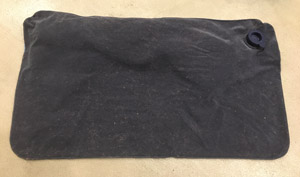
The interior foam liner of my cooling pillow insert became folded over on itself so that half the surface area was unusable.
Cooling Pillow #1: A Cooling Pillow Insert (Water)
The first cooling pillow’s design seemed reasonable enough. The concept is simple: you simply slide a plastic bag containing water, gel or other liquid into your pillow case on top of your existing pillow. There are several different brands and variations available, but most share the descriptive term, “cooling pillow insert.”
This was the cheapest cooling pillow option. I found a water-filled version for just 12 bucks. The bag is about 10×20″ and only about 1/2″ thick. One side of the insert has a soft flocked (textured) surface, which I assume is to help keep it from sliding around inside your pillow.
I didn’t notice it until I unscrewed the water filling valve, but the bag contains a thin layer of polyester foam. When filled, the foam layer absorbs and retains much of the water. This helps to prevent the water from sloshing around to one part of the bag like a water bed does.
There’s a bit of preparation required. Fill it up with warm water, push the air out, seal it and wait for it to cool off—easy enough. Once full, I was surprised by its unique texture. Thanks to the foam, it felt much more like a gel filling than water—very interesting!
To test the cooling pillow insert, I used a shredded latex pillow. It is a good representation of some of the most popular traditional soft pillows in terms of density and breathability, so I figured it would make a good test subject. I slid the insert into my pillow case, on top of the pillow itself, with flocked surface down so that it’d have a little grip and stay put.
The cooling pillow insert was initially impressively cool!
It does in fact keep your head and neck cool. When it sits alone unused, the water inside the insert drops to match the surrounding temperature, which depending on the environment, is around 75 degrees or so. Conversely, your body is a hot and balmy 98.6 degrees. So when you sink your head back into your pillow, it definitely feels cool. I was impressed.
Unfortunately, it doesn’t stay cool forever. The water slowly absorbs the heat from your body until an equilibrium is reached. Then the cooling effect stops. It felt cool for about a half an hour.
“No problem,” I thought to myself, “I fall asleep in less than half hour…”
I fell asleep on it. Unfortunately, it woke me up a few hours later.
While sleeping, the cooling pillow insert slid down to the front edge of my pillow. The plastic bag wrinkled up into an uncomfortable lump and it definitely wasn’t cool any longer. I threw it onto the floor and went back to sleep.
The next day I picked it up and noticed that the foam inside had gotten bunched up along one edge. It seemed impossible to straighten it back out without draining the water and poking around inside with a hook of some sort. The water refused to evenly distribute. The foam in the corner absorbed most of it, keeping it all on one side, effectively halving the usable surface area. You can see this in the photo above—only the top half of the insert has any water in it.
I tried it a second night, but after more listless sleep, I gave up on it. It was not worth draining the water, trying to reconfigure the foam and refilling. The reviews online confirmed that this was a common occurrence.
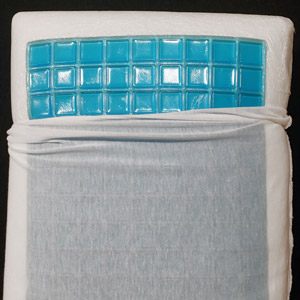
A cooling pillow with a gel layer
Cooling Pillow #2: Memory Foam Pillow with Cooling Gel
You’ve probably heard of memory foam pillows. While they can offer great support for your head and neck, they’re not particularly well-known for their ability to keep you cool due to a lack of breathability. Memory foam can be quite dense, restricting the ability of air to move freely throughout the pillow. Thus, they tend to absorb and retain your body heat.
This memory foam pillow, or “cooling gel pillow” as the manufacturer called it, promised to keep me cool. The concept is the same as with the water-filled cooling pillow insert. The gel layer’s temperature falls to match room temperature, and when you rest your head on it at night, the gel absorbs the heat from your head and neck.
Memory foam has a weird chemical odor.
The pillow came packaged in a zippered plastic bag. When I opened it, I was overwhelmed by a very powerful chemical odor. It almost smelled like mildew or mold. This was the most powerful smelling memory foam pillow I’ve come across. The documentation included with the pillow stated, “new foam products often have a natural and harmless scent or smell. Please air out before use.” I set it aside to allow the “natural” odor to dissipate. A week later, the smell has dissipated a bit, but is still obvious.
This “off gassing” of volatile organic compounds is a common and well-documented property of memory foam pillows and mattresses. The fumes are often compared to those experienced in a freshly painted room. Some of the chemicals used in memory foam aren’t entirely benign. The long-term effects of memory foam and its toxicity is not fully understood, but there clearly is some reason for concern. I believe that declaring off-gassing “natural and harmless” is deceitful.
Of the four cooling pillows I compared, the gel pillow was the least effective.
Initially it was cool, but that feeling did not last. In less than ten minutes, the heat from my head and neck quickly transferred to the gel layer and it warmed up to equalize with my body’s temperature. No more cooling 🙁 I opened the pillow to inspect the gel. The layer, attached to a solid loaf of memory foam, appeared quite thin—less than a 1/4″. It looked to me like there was simply not enough of the gel material to provide any effective or lasting cooling properties.
As a matter of fact, the cooling gel layer became counter-productive as soon as it warmed up. It restricts airflow, as the gel material is contained within an impermeable plastic layer (not that the memory foam beneath the gel was much more breathable). The fact that air cannot move through this layer prevents heat from escaping the pillow and moisture from evaporating.
Cooling ability aside, I didn’t find it very comfortable. The memory foam was a relatively solid, unmoldable loaf. It conformed to the shape of my head and neck, but I couldn’t quite position it the way I wanted. It’d always immediately bounce back to its original box shape.
Both the gel pillow and the water-filled cooling pillow insert only work for a limited time.
They quickly absorb the heat energy from your body. They’re cool initially, but the heat slowly builds up and stays inside. I found that once the cooling effect expired, it wouldn’t return until I removed my head from the pillow and let the cooling materials return to room temperature.
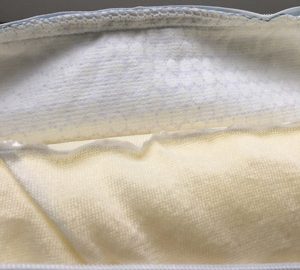
A memory foam pillow enclosed in a cotton PCM infused pillow case.
Cooling Pillow #3: A memory foam pillow with a PCM bead infused pillow case.
Yes, another memory foam pillow. Fortunately this one didn’t smell so much like an oil refinery. It was unique in that it came enclosed in a magical PCM (phase change materials) bead pillow case! Interesting…
PCM materials apparently absorb, store and release heat for optimal comfort. If you’re cold, it heats you up, if you’re hot, it cools you down. That sounds like marketing BS to me, but there’s apparently some legitimate science behind it. PCM technology was originally developed and tested by NASA.
If it worked for NASA, it must be awesome!
I slept on the pillow for several nights. It’s hard to say these PCM beads were in fact absorbing and storing my body heat in a way that kept me cool.
I had a lot of questions.
Didn’t the other products do essentially the same thing: absorb my body heat? Why is it good to “store” it, as opposed to transferring it out of the pillow to the surrounding air? At what temperature did the heat get absorbed and then released again? I had no clue.
It did seem more effective than the memory foam pillow with the gel layer. From what I could tell though, it wasn’t because of the PCM beads. I noticed that the memory foam fill in this pillow was much less dense than the the gel pillow’s. This one was considerably more squishy and seemed to offer a bit more breathability than the more dense material inside the gel pillow. I cut open the fabric liner to investigate the pillow filling. The foam was full of approximately 100 1/2 inch holes. These holes allowed air to pass freely through the pillow. This airflow provides a genuine cooling effect in that it prevents heat build up. Strangely, the product description made no mention of this feature.
I tried it both with and without the pillowcase and couldn’t discern any genuine cooling benefit offered by the PCM beads. The technology does seem to have real potential, but I sure couldn’t see it or measure it. Perhaps pillows are just the wrong application.
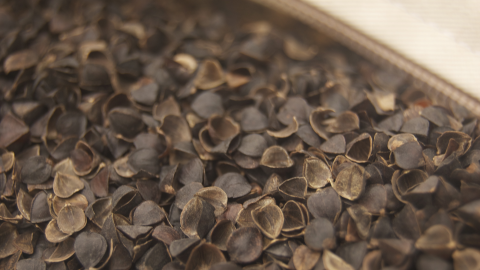
Buckwheat pillows allow warm air absorbed from your body to quickly escape, keeping you cool all night long.
Cooling Pillow #4: Buckwheat Pillow
Buckwheat pillows are filled with thousands of tiny buckwheat hulls. These are the byproduct of milling the buckwheat plant for its nutritious groats (most commonly used to produce soba noodles).
Buckwheat pillows are popular primarily because they provide excellent support for your head and neck. Their buckwheat hull filling’s unique character gives them the ability to shift and conform perfectly to the shape of your body. This allows the weight of your head to be evenly distributed, which will prevent any undue stress on the muscles in your neck and back.
Full disclosure: I already love buckwheat pillows! Several years ago a friend convinced me to try one out. Initially I was very skeptical; firm, hefty and sort of like a bean bag, it was totally unlike any pillow I’d ever tried. It was so different than the soft, squishy down pillows I’d grown up with that it took awhile to get used to it. After a couple weeks, I couldn’t sleep without it. Every other pillow seemed subpar. It was such an awesome pillow that I decided to manufacture and sell them myself.
Buckwheat’s cooling ability is a result of its breathability.
The unique shape of the individual buckwheat hulls allows air to flow more freely through the pillow. This allows warm humid air absorbed from your body to quickly escape the pillow, preventing uncomfortable heat build-up.
Buckwheat vs. the modern cooling pillows
Buckwheat pillows are cooler than other traditional pillow types like down, but I wasn’t so sure how well it’d stack up against these modern cooling pillows that were specifically designed for the task.
After a few nights on each of the different cooling pillows, I began to form some solid conclusions.
The buckwheat pillow is different. While it doesn’t feel immediately cool, like a bag of water, it doesn’t warm up like the other cooling pillows I tried. It stays a comfortable temperature no matter how long I’m on it. The others gradually seemed to become ineffective or worse, counter-productive.
“Sure, sure… How’d you come to these unbiased conclusions, Mr. Buckwheat Pillow Guy?”
OK, I understand your skepticism. I tried to be objective in my methodology for this review. You can argue that my data collection was sloppy (it definitely was!), that I’m biased (maybe a little!), but I feel pretty confident about the results.
I started out by simply sleeping on each pillow for a few days and recording my experience with each (as written above). My arbitrary interpretation of each’s pillows’ relative “coolness” would prove insufficient for a genuine comparison, however. Hopeful that I could gather some solid data from which to draw conclusions, I purchased an infrared thermometer and took lots and lots of temperature readings.
Initial Heat Absorption
The cooling pillows’ surface temperatures all started just above room temperature at 75 degrees. When I rested my head on them, the temperatures would steadily rise until capping at 87-89 degrees within 15 minutes. All of the cooling pillows except the water pillow insert were consistent this way (the water pillow took about 30 minutes).
Despite this consistency, the pillows each were noticeably different in their perceived coolness.
Subsequent Heat Retention
When I first tried recording temperatures, I noticed that I had to act quickly to get a consistent reading after removing my head from the pillows. The temperatures of each pillow dropped at noticeably different rates. Some seemed to expel the heat immediately, while others, like the water filled pillow insert, retained it for a very long time.
I did more temperature readings to test how long each pillow retained the heat absorbed from my body. I rested my head on each pillow for 15 minutes, allowing its surface temperature to warm to about 87-89 degrees. Then I removed my head and recorded the time it took for each to return to room temperature.
The buckwheat pillow was much more effective at transferring the heat energy absorbed from my body back out of the pillow than the other cooling pillow types. It absorbed the body heat at the same rate as every pillow except the water pillow, but it transferred that heat energy back out of the pillow to the surrounding air much more quickly.
The buckwheat pillow dropped to room temperature in just under two minutes, far more quickly than the other cooling pillows:
- 3.5 times faster than the pillow with the memory foam pillow with the PCM infused pillowcase (7 minutes)
- 5 times faster than the gel pillow (10 minutes)
- 45 times faster than the water pillow insert (90 minutes)
Cooling Pillow Conclusions
With the exception of the water pillow insert, the area of each pillow directly in contact with my body remained a consistent temperature. The perceived coolness seemed directly attributable to each pillow’s ability to transfer heat away from the pillow to the air surrounding it. The coolest feeling pillows simply did not retain the heat. As it turns out, breathable pillows are most effective at expelling excess heat.
Both the gel pillow and the cooling pillow insert were a disappointment. That said, their ability to provide quick powerful cooling relief does have an application. For those in need of immediate, or temporary relief, a water or gel filled device might be a reasonable option for you. If the device contains an adequate amount of liquid/gel, they will provide a quick and strong cooling sensation that other pillows can’t provide. The length of time that the device will be effective will depend on both its size and the room’s temperature. Once you exhaust its cooling function, I expect you’ll feel like me and your so-called cooling pillow will end up on the floor. These types of cooling pillow designs aren’t effective for an entire sleep cycle, thus I would not recommend either that I tested.
The PCM infused fabric pillow case was a genuine mystery to me. I fell for the high-tech sounding marketing lingo. The science sounded pretty neato, but I honestly couldn’t detect any perceived or measurable cooling effect. I wasn’t able to determine what was happening with regards to either heat absorption or retention, the magic of the PCM material. Where the PCM beads absorbing and storing heat in a way that kept me cool? I sure couldn’t tell. Being that the case, my conclusion is that it simply doesn’t work. Maybe NASA can make one for us that does!
The buckwheat pillow, the most breathable type, was the best cooling pillow. It kept me cool all night without gimmicks or weird science.
The modern alternatives to my trusty buckwheat pillow weren’t very impressive. Compared to a proven, simple, all-natural solution, they were all wholly inadequate. It was obvious to me both from my personal experience sleeping on each of the pillows and from the temperature readings I collected: the breathable buckwheat pillows kept me noticeably cooler thanks to the simple fact that air was able to circulate through the filling.
If you’re looking for a cooling pillow that really works, I strongly recommend a buckwheat pillow. Don’t take my word for it. Our customers’ reviews speak for themselves!
“I got this as a father’s day present from my wife and kids. Ever since I got it (it’s August now) I can’t recall having a single night where I was feeling hot and sweaty on my head. This alone has made Hullo be the best pillow I’ve ever owned.” –M. Sandoval, verified Hullo customer
I’ll be the first to admit that buckwheat pillows aren’t for everyone. Being quite firm, they can take some getting used to. If a firm buckwheat pillow is not an option you’re willing to consider, try shopping for “breathable pillows” rather than the not-so-effective alternatives I’ve reviewed here.



